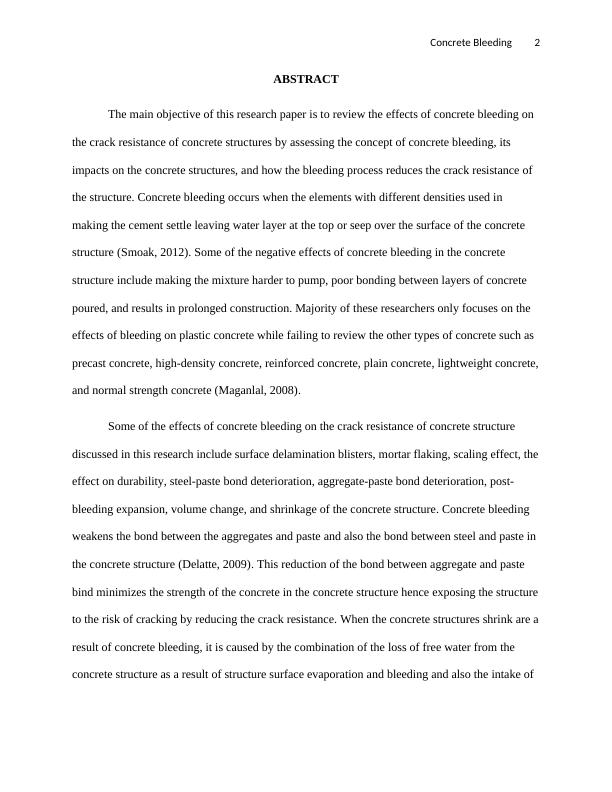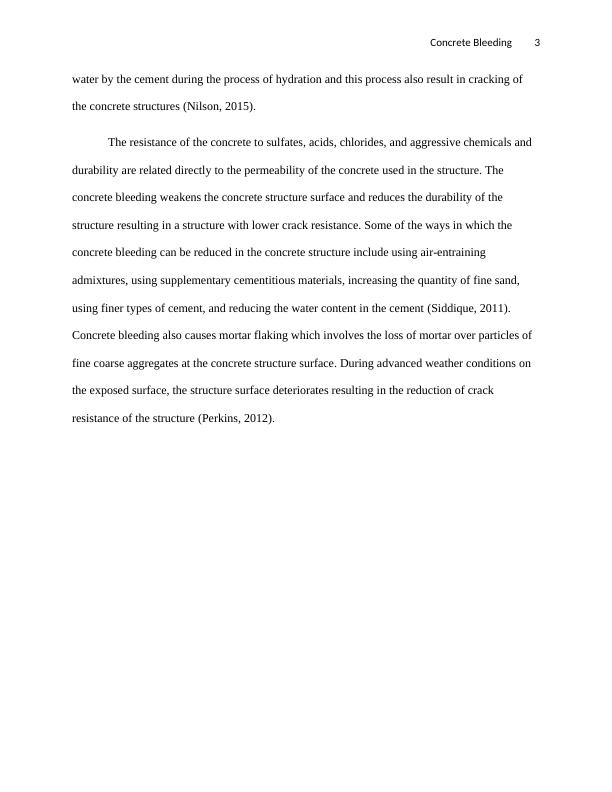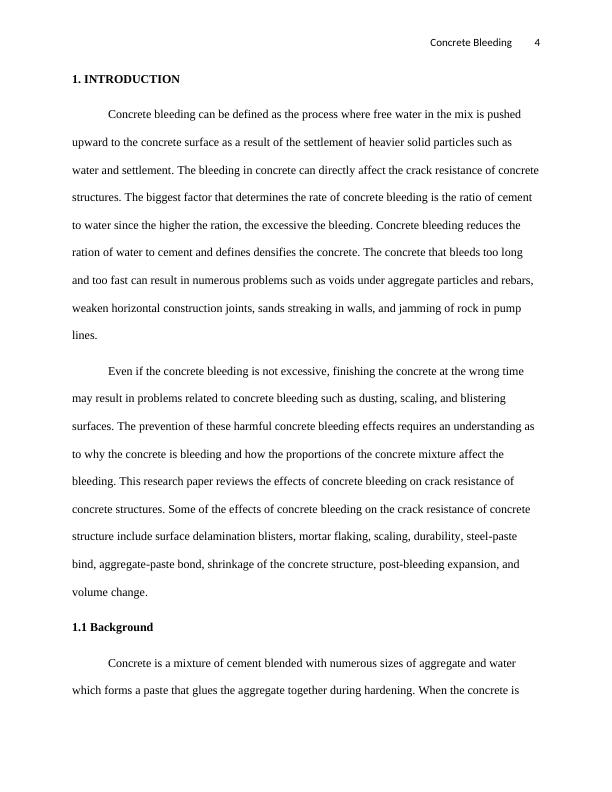Effects of Concrete Bleeding on Crack Resistance of Concrete Structures
Added on 2023-06-07
16 Pages4237 Words483 Views
Concrete Bleeding 1
EFFECT OF CONCRETE BLEEDING ON CRACK RESISTANCE OF CONCRETE
STRUCTURES
A Research Paper on Concrete By
Student’s Name
Name of the Professor
Institutional Affiliation
City/State
Year/Month/Day
EFFECT OF CONCRETE BLEEDING ON CRACK RESISTANCE OF CONCRETE
STRUCTURES
A Research Paper on Concrete By
Student’s Name
Name of the Professor
Institutional Affiliation
City/State
Year/Month/Day

Concrete Bleeding 2
ABSTRACT
The main objective of this research paper is to review the effects of concrete bleeding on
the crack resistance of concrete structures by assessing the concept of concrete bleeding, its
impacts on the concrete structures, and how the bleeding process reduces the crack resistance of
the structure. Concrete bleeding occurs when the elements with different densities used in
making the cement settle leaving water layer at the top or seep over the surface of the concrete
structure (Smoak, 2012). Some of the negative effects of concrete bleeding in the concrete
structure include making the mixture harder to pump, poor bonding between layers of concrete
poured, and results in prolonged construction. Majority of these researchers only focuses on the
effects of bleeding on plastic concrete while failing to review the other types of concrete such as
precast concrete, high-density concrete, reinforced concrete, plain concrete, lightweight concrete,
and normal strength concrete (Maganlal, 2008).
Some of the effects of concrete bleeding on the crack resistance of concrete structure
discussed in this research include surface delamination blisters, mortar flaking, scaling effect, the
effect on durability, steel-paste bond deterioration, aggregate-paste bond deterioration, post-
bleeding expansion, volume change, and shrinkage of the concrete structure. Concrete bleeding
weakens the bond between the aggregates and paste and also the bond between steel and paste in
the concrete structure (Delatte, 2009). This reduction of the bond between aggregate and paste
bind minimizes the strength of the concrete in the concrete structure hence exposing the structure
to the risk of cracking by reducing the crack resistance. When the concrete structures shrink are a
result of concrete bleeding, it is caused by the combination of the loss of free water from the
concrete structure as a result of structure surface evaporation and bleeding and also the intake of
ABSTRACT
The main objective of this research paper is to review the effects of concrete bleeding on
the crack resistance of concrete structures by assessing the concept of concrete bleeding, its
impacts on the concrete structures, and how the bleeding process reduces the crack resistance of
the structure. Concrete bleeding occurs when the elements with different densities used in
making the cement settle leaving water layer at the top or seep over the surface of the concrete
structure (Smoak, 2012). Some of the negative effects of concrete bleeding in the concrete
structure include making the mixture harder to pump, poor bonding between layers of concrete
poured, and results in prolonged construction. Majority of these researchers only focuses on the
effects of bleeding on plastic concrete while failing to review the other types of concrete such as
precast concrete, high-density concrete, reinforced concrete, plain concrete, lightweight concrete,
and normal strength concrete (Maganlal, 2008).
Some of the effects of concrete bleeding on the crack resistance of concrete structure
discussed in this research include surface delamination blisters, mortar flaking, scaling effect, the
effect on durability, steel-paste bond deterioration, aggregate-paste bond deterioration, post-
bleeding expansion, volume change, and shrinkage of the concrete structure. Concrete bleeding
weakens the bond between the aggregates and paste and also the bond between steel and paste in
the concrete structure (Delatte, 2009). This reduction of the bond between aggregate and paste
bind minimizes the strength of the concrete in the concrete structure hence exposing the structure
to the risk of cracking by reducing the crack resistance. When the concrete structures shrink are a
result of concrete bleeding, it is caused by the combination of the loss of free water from the
concrete structure as a result of structure surface evaporation and bleeding and also the intake of

Concrete Bleeding 3
water by the cement during the process of hydration and this process also result in cracking of
the concrete structures (Nilson, 2015).
The resistance of the concrete to sulfates, acids, chlorides, and aggressive chemicals and
durability are related directly to the permeability of the concrete used in the structure. The
concrete bleeding weakens the concrete structure surface and reduces the durability of the
structure resulting in a structure with lower crack resistance. Some of the ways in which the
concrete bleeding can be reduced in the concrete structure include using air-entraining
admixtures, using supplementary cementitious materials, increasing the quantity of fine sand,
using finer types of cement, and reducing the water content in the cement (Siddique, 2011).
Concrete bleeding also causes mortar flaking which involves the loss of mortar over particles of
fine coarse aggregates at the concrete structure surface. During advanced weather conditions on
the exposed surface, the structure surface deteriorates resulting in the reduction of crack
resistance of the structure (Perkins, 2012).
water by the cement during the process of hydration and this process also result in cracking of
the concrete structures (Nilson, 2015).
The resistance of the concrete to sulfates, acids, chlorides, and aggressive chemicals and
durability are related directly to the permeability of the concrete used in the structure. The
concrete bleeding weakens the concrete structure surface and reduces the durability of the
structure resulting in a structure with lower crack resistance. Some of the ways in which the
concrete bleeding can be reduced in the concrete structure include using air-entraining
admixtures, using supplementary cementitious materials, increasing the quantity of fine sand,
using finer types of cement, and reducing the water content in the cement (Siddique, 2011).
Concrete bleeding also causes mortar flaking which involves the loss of mortar over particles of
fine coarse aggregates at the concrete structure surface. During advanced weather conditions on
the exposed surface, the structure surface deteriorates resulting in the reduction of crack
resistance of the structure (Perkins, 2012).

Concrete Bleeding 4
1. INTRODUCTION
Concrete bleeding can be defined as the process where free water in the mix is pushed
upward to the concrete surface as a result of the settlement of heavier solid particles such as
water and settlement. The bleeding in concrete can directly affect the crack resistance of concrete
structures. The biggest factor that determines the rate of concrete bleeding is the ratio of cement
to water since the higher the ration, the excessive the bleeding. Concrete bleeding reduces the
ration of water to cement and defines densifies the concrete. The concrete that bleeds too long
and too fast can result in numerous problems such as voids under aggregate particles and rebars,
weaken horizontal construction joints, sands streaking in walls, and jamming of rock in pump
lines.
Even if the concrete bleeding is not excessive, finishing the concrete at the wrong time
may result in problems related to concrete bleeding such as dusting, scaling, and blistering
surfaces. The prevention of these harmful concrete bleeding effects requires an understanding as
to why the concrete is bleeding and how the proportions of the concrete mixture affect the
bleeding. This research paper reviews the effects of concrete bleeding on crack resistance of
concrete structures. Some of the effects of concrete bleeding on the crack resistance of concrete
structure include surface delamination blisters, mortar flaking, scaling, durability, steel-paste
bind, aggregate-paste bond, shrinkage of the concrete structure, post-bleeding expansion, and
volume change.
1.1 Background
Concrete is a mixture of cement blended with numerous sizes of aggregate and water
which forms a paste that glues the aggregate together during hardening. When the concrete is
1. INTRODUCTION
Concrete bleeding can be defined as the process where free water in the mix is pushed
upward to the concrete surface as a result of the settlement of heavier solid particles such as
water and settlement. The bleeding in concrete can directly affect the crack resistance of concrete
structures. The biggest factor that determines the rate of concrete bleeding is the ratio of cement
to water since the higher the ration, the excessive the bleeding. Concrete bleeding reduces the
ration of water to cement and defines densifies the concrete. The concrete that bleeds too long
and too fast can result in numerous problems such as voids under aggregate particles and rebars,
weaken horizontal construction joints, sands streaking in walls, and jamming of rock in pump
lines.
Even if the concrete bleeding is not excessive, finishing the concrete at the wrong time
may result in problems related to concrete bleeding such as dusting, scaling, and blistering
surfaces. The prevention of these harmful concrete bleeding effects requires an understanding as
to why the concrete is bleeding and how the proportions of the concrete mixture affect the
bleeding. This research paper reviews the effects of concrete bleeding on crack resistance of
concrete structures. Some of the effects of concrete bleeding on the crack resistance of concrete
structure include surface delamination blisters, mortar flaking, scaling, durability, steel-paste
bind, aggregate-paste bond, shrinkage of the concrete structure, post-bleeding expansion, and
volume change.
1.1 Background
Concrete is a mixture of cement blended with numerous sizes of aggregate and water
which forms a paste that glues the aggregate together during hardening. When the concrete is

End of preview
Want to access all the pages? Upload your documents or become a member.
Related Documents
Causes of Concrete Degradation and Ways to Improve Durabilitylg...
|3
|751
|313
Effects of Specimen Size on Efficiency of Shape Memory Polymers in Self-healing Concretelg...
|7
|1563
|195
Construction Defects Assignment PDFlg...
|8
|1596
|201
Corrosion and Deterioration of RC Structurelg...
|29
|7341
|289
Concrete Mix & Cast Report - Design, Constituents, Resultslg...
|7
|1051
|442
Corrosion of Steel in Concretelg...
|9
|2112
|1
